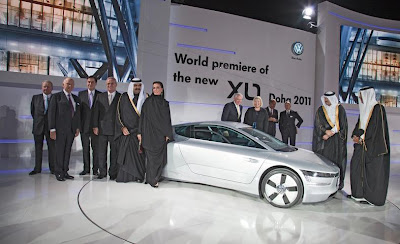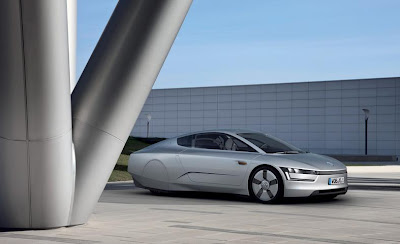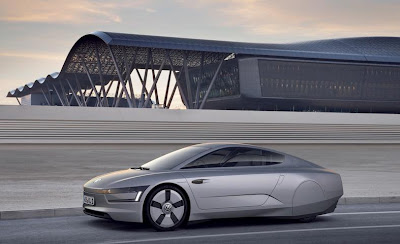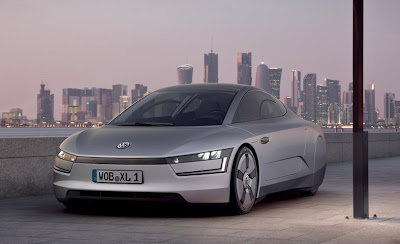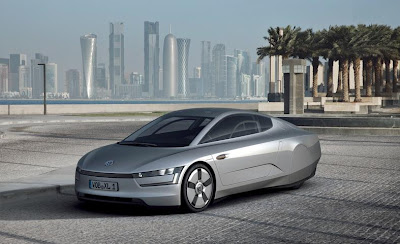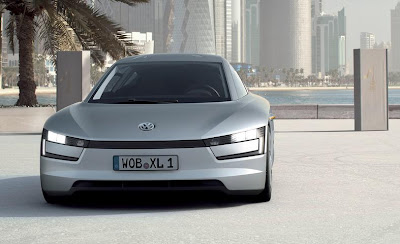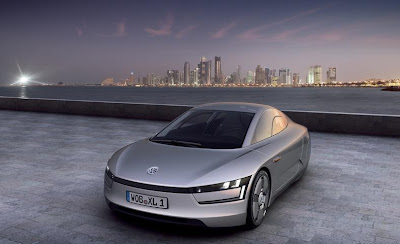Future mobility is one of the most stimulating subjects of our time. The crucial question listed here: Merely the amount of could the power consumption of cars be reduced if all the stops were pulled out for effectiveness? There is now an answer to this concern, and Volkswagen is providing it through the new Volkswagen XL1 Concept Integrated gas intake: 0.9 l/100 km. No other hybrid car powered by an electric motor / internal combustion engine combination is more fuel reliable. The model makes its world launching at the 2011 Qatar Motor Say (26-29 January, 2011).
2011 Volkswagen XL1 Concept
2011 Volkswagen XL1 Concept
Conceptually, the Volkswagen XL1 represents the third evolutionary phase of Volkswagen's 1-litre automobile method. When the new centuries was initiated, Prof. Dr. Ferdinand PiÃ"ch, that is today Chairman of the Supervisory Board of Volkswagen AG, made the lofty objective of offering the marketplace a manufacturing auto that was sensible for day-to-day use with a gas usage of 1.0 litre each 100 km. In the new XL1, Volkswagen is showing that this target is now accessible.
2011 Volkswagen XL1 Concept
2011 Volkswagen XL1 Concept
2011 Volkswagen XL1 Concept
2011 Volkswagen XL1 Concept
2011 Volkswagen XL1 Concept
2011 Volkswagen XL1 Concept
2011 Volkswagen XL1 Concept
2011 Volkswagen XL1 Concept
2011 Volkswagen XL1 Concept
2011 Volkswagen XL1 Concept
2011 Volkswagen XL1 Concept
2011 Volkswagen XL1 Concept
2011 Volkswagen XL1 Concept
2011 Volkswagen XL1 Concept
2011 Volkswagen XL1 Concept
2011 Volkswagen XL1 Concept
2011 Volkswagen XL1 Concept
Regardless of the extremely high degrees of efficiency, designers had the ability to design a physique format that provides better daily functionality, integrating side by side seating as opposed to the tandem arrangement seen in both the first 1-litre car offered in 2002 and the L1 offered in 2009. In the new Volkswagen XL1, wing doors make it much easier to enter and leave the vehicle. More development has actually been made by producing physique parts from carbon fiber improved polymer components (CFRP), a technique made use of in Formula 1 car building. Once more, Volkswagen has efficiently attained significant decreases in production costs - a crucial advance to make realistic a limited production run of the XL1. History: in addition to suppliers, Volkswagen has actually developed and patented a brand-new system for CFRP production in exactly what is referred to as the aRTM procedure (state-of-the-art Resin Transmission Moulding).
Plug-in hybrid idea
With the brand-new XL1, Volkswagen is implementing a plug-in hybrid concept, which makes use of the fuel efficient modern technology of the typical rail turbodiesel (TDI) and the twin clutch transmission (DSG). The TDI produces its stated max power of 35 kW/48 PS from simply 0.8 litre displacement. The whole hybrid facility is housed mentioned above the car's steered back axle. The real hybrid module with electric motor and clutch is placed in between the TDI and the 7-speed DSG; this component was incorporated in the DSG transmission case instead of the usual flywheel. The integrated lithium-ion battery provides the E-motor with power. The high voltage electricity circulation from and to the battery or E-motor is managed by the power electronics, which runs at 220 Volts. The Volkswagen XL1's physique electrical system is supplied with the needed 12 Volts with a DC/DC converter.
Interplay of E-motor and TDI engine: The E-motor assists the TDI in velocity (boosting), but as described it could additionally power the XL1 Principle on its own for a proximity of around 35 km. In this method, the TDI is decoupled from the drivetrain by disengaging a clutch, and it is closed down. On the other hand, the clutch on the gearbox side continues to be shut, so the DSG is totally engaged with the electric motor. Important: The driver could opt to drive the Volkswagen XL1 in pure electric method (supplied that the battery is completely asked for). As early as the electric method button on the tool panel is pressed, the automobile is pushed specifically by electric power. Restarting of the TDI is an extremely hassle-free and comfy procedure: In exactly what is understood as "rhythm starting" of the TDI engine while steering, the electric motor's blades is sped up and is really rapidly combined to the engine clutch. This speeds up the TDI to the needed rate and starts it. The whole procedure occurs without any sort of blows, so the motorist barely notices the TDI engine restarting.
When the XL1 is braked, the E-motor runs as a generator that makes use of the braking energy to bill the battery (battery regeneration). In particular operating disorders the bunch shared between the TDI engine and the electric motor can be changed so that the turbodiesel is running at its most favourable performance degree. The equipments of the instantly shifting 7-speed DSG are likewise constantly selected with the aim of reducing power use. The engine operator moderates all energy flow and drive management activities, considering the power required at any sort of provided moment by the vehicle driver. A few of the specifications utilized to understand the optimum propulsion method for the provided ailments are: accelerator pedal position and engine load, as well as the electricity provide and mix of kinetic and electrical electricity at any offered time.
Two-cylinder TDI utilizes automation modern technology: The 0.8 litre TDI (35 kW/48 PS) was stemmed from the 1.6 litre TDI, which steers such autos as the Golf and Passat. The 0.8 TDI exhibits the same information as the 1.6-litre TDI typical rail engine in terms of cyndrical tube spacing (88 mm), cylinder bore (79.5 mm) and stroke (80.5 mm). On top of that, the Volkswagen XL1 Concept's two-cylinder and the mass produced four cylinder share key interior engine functions for lessening exhausts. They include special piston recesses for several shot and individual orientation of the specific treatment jets. The excellent, smooth starting assets of the typical rail engines were moved to the 2 cylinder engine. within addition, a balancer shaft that is steered by the crankshaft turning at the very same rate optimises smooth engine operating.
At the same time, the TDI's aluminium crankcase was constructed to achieve higher rigidity and preciseness, which consequently brings about very reduced abrasion losses. With the goal of decreasing emissions, exhaust gas recirculation and an oxidation catalytic converter as well as a diesel particulate filter are utilized. Geared up in this way, the 0.8 TDI already fulfils the limits of the Euro-6 emissions basic.
Also made for effectiveness is the auto's cooling down system. Engine management only cools down the TDI by turning on an on the surface steered electric water pump when engine operating problems require it. This cooling down system includes an automatically controlled air intake system at the front of the car to reduce cooling system bother. This thermal administration method also adds to decreased fuel intake. A 2nd electric water pump, which is additionally made use of only as required, distributes a separate reduced temperature level coolant loop to cool the starter generator and power electronic devices.
Starting equipment with ESP uses modern products
The starting equipment is prepared with anti-roll bars at the front and rear end and is characterised by lightweight building with optimal security. Ahead, a dual wishbone suspension is utilized, while a semi-trailing link system is used at the back. The front and back suspension are each of the very compact in building and offer a high degree of driving comfort. The operating gear components install straight to the CFRP monocoque in crucial locations.
Starting gear weight has actually been lowered by the usage of aluminium lightweight parts (including suspension elements, brake calipers, dampers, steering equipment real estate), CFRP (anti-roll bars), ceramics (brake discs) magnesium mineral (wheels) and plastics (steering wheel body). Friction-optimised tire bearings and drive shafts, and also a totally brand-new generation of optimised reduced rolling resistance tyres from MICHELIN (front: 115/80 R 15; rear: 145/55 R 16), add to the low energy consumption of the Volkswagen XL1 Principle. Safety gains are understood by an anti-lock stopping system (ABS) and digital stabilisation program (ESP). That is since durability without optimum protection would certainly not actually be an action ahead. The brand-new VW XL1 shows how these two specifications could be brought into consistency.
Tuesday, October 9, 2012
Qatar Motor Show
Volkswagen
